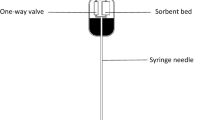Abstract
Two sample preparation methods were introduced and compared in this paper to establish a simple, quick and exact analysis of geosmin and 2-methylisoborneol. LC-18 column was employed in solid phase extraction (SPE), 1.0 mL of hexane was adopted in liquid-liquid extraction (LLE), and the extracts were analyzed by gas chromatograph mass spectrum (GCMS) in selected ion mode. Mean recoveries of SPE were low for 2-methylisoborneol (2-MIB) and geosmin (GSM) with values below 50%. For LLE, the recoveries were satisfyingly above 50% for 2-MIB and 80% for GSM. Detection limits of the LLE method were as low as 1.0 ng/L for GSM and 5.0 ng/L for 2-MIB. A year-long investigation on odor chemicals of drinking water in Shanghai demonstrated that in the summer, there was a serious odor problem induced by a high concentration of 2-MIB. The highest concentration of 152.82 ng/L appeared in July in raw water, while GSM flocculation was minimal with concentrations below odor threshold.
Similar content being viewed by others
References
Krasner S W, Hwang C J, McGuire M J. A standard method for quantification of earthy-musty odorants in water, sediments and algal cultures. Water Sci Technol, 1983, 15: 127–138
Mallevialle J, Suffet I H. Identification and Treatment of Tastes and Odours in Drinking Water (Chapter 7). American Water Works Association Research Foundation Cooperative Research Report No. 211. 1987
Persson P E. Off-flavours in aquatic ecosystems-an introduction. Water Sci Technol, 1983, 15(6/7): 1–11
Young W F, Horth H, Crane R, Ogden T, Arnott M. Taste and odour threshold concentrations of potential potable water contaminants. Water Research, 1996, 30: 331–340
Worley J L, Dietrich A M, Hoehn R C. Dechlorination techniques for improved sensory odor testing of geosmin, and 2-MIB. J Am Water Works Assoc, 2003, 95(3): 34–41
Rashash D M C, Dietrich A M, Hoehn R C. FPA of selected odorous compounds. J Am Water Works Assoc, 1997, 89(2): 131–141
Andrew J W, Andrea M D. Relationship between intensity, concentration, and temperature for drinking water odorants. Water Research, 2004, 38(6): 1,604–1,614
Brownlee B G, Gaminie L A. Simple extraction procedure for moderately volatile taste and odor compounds such as geosmin and 2-methylisoborneol-method and applications. Water Sci Technol, 1988, 20: 91–97
Bao M L, Barbieri K, Burrini D, Griffini O, Pantani F. Determination of trace levels of taste and odor compounds in water by microextraction and gas-chromatography-ion-trap detection-mass spectrometry. Water Research, 1998, 31: 1,719–1,722
Shin H S, Ahn H S. Simple, rapid, and sensitive determination of odorous compounds in water by GC-MS. Chromatographia, 2000, 59(1): 107–113
Method 2150. Standard Methods for the Examination of Water and Wastewater. Washington, USA: American Public Health Association (APHA), American Water Works (AWWA), Association & Water Pollution Control Federation (WPCF), 1995, 16–23
Khiari D, Suffet I H, Barrett S E. The determination of compounds causing fishy/swampy odors in drinking water supplies. Water Sci Technol, 1995, 31(11): 105–112
Lloyd S W, Lea J M, Zimba P V, Grimm C C. Rapid analysis of geosmin and 2-methylisoborneol in water using solid phase micro extraction procedures. Water Research, 1998, 32: 2,140–2,146
McCallum R, Pendleton P, Schumann R, Trinh M U. Determination of geosmin and 2-methyliso-borneol in water using solid-phase microextraction and gas chromatography-chemical ionization/electron impact ionization-ion-trap mass spectrometry. Analyst, 1998, 123: 2,155–2,160
Watson S, Brownlee B, Satchwill T, McCauley E. The use of solid phase microextraction (SPME) to monitor for major organoleptic compounds produced by chrysophytes in surface waters. Water Sci Technol, 1999, 40(6): 251–256
Author information
Authors and Affiliations
Corresponding author
Rights and permissions
About this article
Cite this article
Ma, X., Gao, N., Chen, B. et al. Detection of geosmin and 2-methylisoborneol by liquid-liquid extraction-gas chromatograph mass spectrum (LLE-GCMS) and solid phase extraction-gas chromatograph mass spectrum (SPE-GCMS). Front.Environ.Sci.Eng.China 1, 286–291 (2007). https://doi.org/10.1007/s11783-007-0048-7
Received:
Accepted:
Issue Date:
DOI: https://doi.org/10.1007/s11783-007-0048-7



